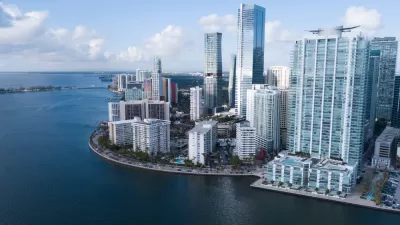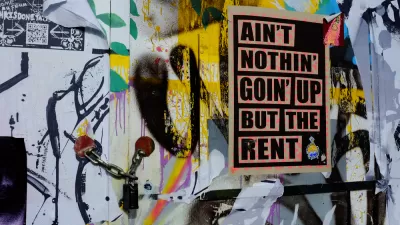New data shows stratospheric housing costs in cities not named New York.

First it was Austin; now it's Miami. There is no longer an undisputed champion of the U.S. housing affordability crisis.
The RealtyHop Affordability Index for February identifies Miami as the least affordable city in the United States, above even New York (#2) and Los Angeles (#3). The report used projected median household income, local property tax data from the American Community Survey, and median for-sale home listing prices via RealtyHop data to create the index.
An article by Katherine Kallergis for the Real Deal provides more insight into the report's findings and context for the city's housing market. According to Kallergis, Miami's soaring housing prices are "propelled by the migration of out-of-state buyers and renters, many of whom have moved from the Northeast," and the relatively slow growth of wages over the same period.
The for-sale market isn't the only sign of Miami's runaway housing market. In December 2021, a separate report by Zumper estimated that rents were growing faster in Miami than anywhere else in the country. An article by Susannah Cavanaugh shares insight into the Zumper report.
Both the Zumper report and the RealtyHop warrant a caveat about housing price figures that rely on online listings, which can distort their picture of the market, as documented by numerous media observers over the years, including an article by Joe Cortright from 2018.
With those caveats in mind, it's still notable that the list of undisputed "most expensive cities" in the United States is shifting into new corners of the Sunbelt. The RealtyHop report comes just a few months after a Zillow forecast predicted Austin would soon be the most expensive homebuying market ouside California, for example. The runaway housing market has crossed state lines.
FULL STORY: Miami becomes least affordable housing market in the US

Trump Administration Could Effectively End Housing Voucher Program
Federal officials are eyeing major cuts to the Section 8 program that helps millions of low-income households pay rent.

Planetizen Federal Action Tracker
A weekly monitor of how Trump’s orders and actions are impacting planners and planning in America.

Ken Jennings Launches Transit Web Series
The Jeopardy champ wants you to ride public transit.

Washington Legislature Passes Rent Increase Cap
A bill that caps rent increases at 7 percent plus inflation is headed to the governor’s desk.

From Planning to Action: How LA County Is Rethinking Climate Resilience
Chief Sustainability Officer Rita Kampalath outlines the County’s shift from planning to implementation in its climate resilience efforts, emphasizing cross-departmental coordination, updated recovery strategies, and the need for flexible funding.

New Mexico Aging Department Commits to Helping Seniors Age ‘In Place’ and ‘Autonomously’ in New Draft Plan
As New Mexico’s population of seniors continues to grow, the state’s aging department is proposing expanded initiatives to help seniors maintain their autonomy while also supporting family caregivers.
Urban Design for Planners 1: Software Tools
This six-course series explores essential urban design concepts using open source software and equips planners with the tools they need to participate fully in the urban design process.
Planning for Universal Design
Learn the tools for implementing Universal Design in planning regulations.
Heyer Gruel & Associates PA
Ada County Highway District
Institute for Housing and Urban Development Studies (IHS)
City of Grandview
Harvard GSD Executive Education
Toledo-Lucas County Plan Commissions
Salt Lake City
NYU Wagner Graduate School of Public Service





























